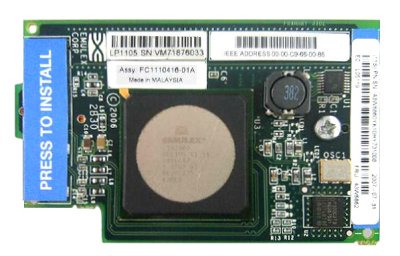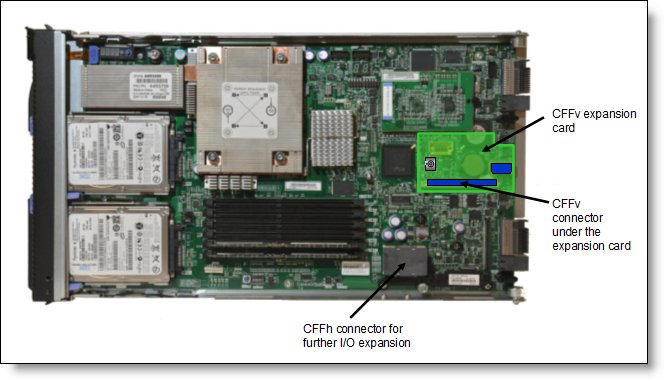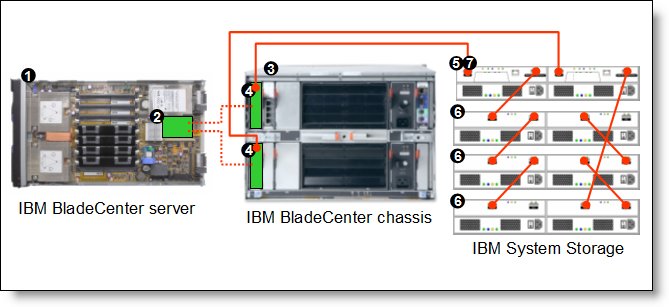Abstract
The Emulex 4 Gb Fibre Channel Expansion Card (CFFv) for IBM BladeCenter enables high-performance connection to a storage area network (SAN). Thanks to the innovative design of the IBM BladeCenter midplane, this Fibre Channel adapter operates without the need for an SFP module, thereby saving you significant hardware costs. Each adapter provides dual paths to the SAN switches to ensure full redundancy, while the exclusive firmware-based architecture allows firmware and features to be upgraded without taking the server off-line or rebooting, and without the need to upgrade the driver.
Note: This product has been withdrawn from marketing and is no longer available for ordering from IBM.
Changed in the 6/19/2013 update:
* The IBM BladeCenter Optical Pass-thru Module, 39Y9316, is not supported
Introduction
The Emulex 4 Gb Fibre Channel Expansion Card (CFFv) for IBM BladeCenter enables high-performance connection to a storage area network (SAN). Thanks to the innovative design of the IBM BladeCenter midplane, this Fibre Channel adapter operates without the need for an SFP thereby, hence saving you significant hardware costs. Each adapter provides dual paths to the SAN switches to ensure full redundancy, while the exclusive firmware-based architecture allows firmware and features to be upgraded without taking the server off-line or rebooting, and without the need to upgrade the driver.
This card is installed into the CFFv slot of the supported blade server and provides connections to BladeCenter I/O modules located in bays 3 and 4 of the supported BladeCenter chassis. The CFFv slot is a PCI-X 2.0 slot. The Emulex 4 Gb Fibre Channel Expansion Card (CFFv) is shown in Figure 1.

Figure 1. Emulex 4 Gb Fibre Channel Expansion Card (CFFv)
Did you know?
When using this CFFv adapter, you can simultaneously use a CFFh adapter to enable more types of I/O to supported blade servers such as the HS21 when installed on the IBM BladeCenter H chassis.
You can upgrade the firmware of Emulex Host Bus Adapters (HBAs) without taking the server off-line or rebooting. This is an exclusive Emulex feature that minimizes downtime and protects investment in a client's infrastructure.
Part number information
| Description | Part number | Feature code |
| Emulex 4 Gb Fibre Channel Expansion Card (CFFv) for IBM BladeCenter | 43W6859 | 2994 |
This part number includes the following items:
- One Emulex 4 Gb Fibre Channel Expansion Card (CFFv) for IBM BladeCenter
- IBM Getting Started Guide (flyer)
- Documentation CD Version 1.0, which contains the Emulex 4 Gb Fibre Channel Expansion Card (CFFv) for IBM BladeCenter Installation and User’s Guide
- Safety Information document
- End user license agreement
Features
- Enables high-speed and dual-port connection to a Fibre Channel SAN
- Integrated design allows use of a CFFh adapter in the BladeCenter H chassis
- Comprehensive virtualization capabilities with support for N_Port ID Virtualization (NPIV) and Virtual Fabric
- Simplified installation and configuration using common HBA drivers
- Efficient administration via HBAnyware for HBAs anywhere in the SAN
- Common driver model eases management and enables upgrades independent of HBA firmware
- Supports BladeCenter Open Fabric Manager
IBM BladeCenter leads the industry in delivering integrated fabric switching to the blade server environment. Integrated fabric switching eases deployment, simplifies the data center, reduces cabling and optical transceivers (SFPs), and lowers costs. BladeCenter clients have the flexibility to choose from a variety of SAN switch vendor's architectures. The BladeCenter SAN switch module portfolio now includes QLogic, Brocade, and Cisco.
Each BladeCenter server provides redundant connections to data and storage networks. Clients can configure their blade servers with dual port host bus adapters and be assured that they will always have a connection to their Storage Area Network (SAN) via BladeCenter's high availability midplane. Through integration, BladeCenter eliminates the fiber cables from the server to the switch. This not only reduces the opportunity for misconfiguration, it lowers the expense for cables and optical transceivers (SFPs), and reduces potential points of failure, while increasing network availability.
Specifications
- Fibre Channel specifications:
- Bandwidth: Burst transfer rate of 800 Mbytes/sec full-duplex per port
- Support for both FCP-SCSI and IP protocols
- Support for point-to-point fabric connection: F-Port Fabric Login
- Support for FCAL and FCAL-2 FL-Port Login
- Support for Fibre Channel services class 2 and 3
- Support for full-duplex operation
- Single-chip design with two completely independent 4 Gb serial Fibre Channel ports. Each port provides:
- Reduced instruction set computer (RISC) processor
- Integrated serializer/deserializer
- Receive direct memory access (DMA) sequencer
- Frame buffer
- Host data transfer: Burst data transfers up to 1 GB per second.
- Onboard DMA: DMA controller for each port: Transmit and receive.
- Frame buffer first in, first out (FIFO): Integrated 63 KB transmit and 32 KB receive frame buffer for each data channel
- Internal memory:
- 1.5 MB internal high-speed SRAM, ECC protected
- 4 MB non-volatile RAM (NVRAM), 2 MB per port
Operating environment
- Temperature and altitude
- Operating
- 10° to 52°C (50° to 125.6°F) at an altitude of 0 to 914 m (0 to 3,000 ft)
- 10° to 49°C (50° to 120.2°F) at an altitude of 0 to 3,000 m (0 to 10,000 ft)
- Non-operating: 40° to 65°C (-40° to 149°F) at an altitude of 0 to 12,000 m (0 to 39,370 ft)
- Operating
- Humidity
- Operating: 8% to 80%, noncondensing
- Non-operating: 5% to 80%, noncondensing
Supported servers and I/O modules
The Emulex 4 Gb Fibre Channel Expansion Card (CFFv) is supported in the IBM BladeCenter servers listed in Table 2.
Table 2. Supported servers
|
Expansion card |
Part number |
|
|
|
|
|
|
|
|
|
|
|
|
|
|
Emulex 4 Gb FC Expansion Card (CFFv) |
43W6859 |
Y |
Y |
Y |
N |
Y |
Y |
Y |
Y |
Y |
N |
Y |
N |
N |
The Emulex 4 Gb FC Expansion Card (CFFv) is also supported in an expansion blade when the blade server supports both the Emulex expansion card and that particular expansion blade. Figure 2 shows where the CFFv card is installed in a BladeCenter server.

Figure 2. Location on the BladeCenter server planar where the CFFv card is installed
See IBM ServerProven for the latest information about the expansion cards supported by each blade server type: http://ibm.com/servers/eserver/serverproven/compat/us/.
IBM BladeCenter chassis support is based on the blade server type on which the expansion card is installed. Consult ServerProven to see which chassis each blade server type is supported in: http://ibm.com/servers/eserver/serverproven/compat/us/.
The Emulex 4 Gb Fibre Channel Expansion Card (CFFv) supports the following I/O modules installed in the IBM BladeCenter chassis.
- Fibre Channel Switch Modules
- QLogic 4 Gb Intelligent Pass-thru Module
- QLogic 8 Gb Intelligent Pass-thru Module
Specific I/O modules supported with the Emulex 4 Gb Fibre Channel Expansion Card (CFFv) are shown in Table 3. The table also lists the BladeCenter chassis that support each I/O module. One I/O module must be installed in I/O bay 3 or 4 in the BladeCenter chassis. For redundancy and performance purposes, we recommend you install two I/O modules in the chassis, one in bay 3 and one in bay 4.
Table 3. I/O modules supported with the Emulex 4 Gb Fibre Channel Expansion Card (CFFv)
|
I/O module |
Part number |
|
|
|
|
|
|
Brocade 4 Gb 20-Port SAN Switch Module |
32R1812 |
N |
Y |
Y |
Y |
Y |
|
Brocade 4 Gb 10-Port SAN Switch Module |
32R1813 |
Y |
Y |
Y |
Y |
Y |
|
Cisco 4 Gb 20-Port Fibre Channel Switch Module |
39Y9280 |
N |
Y |
Y |
Y |
Y |
|
Cisco 4 Gb 10-Port Fibre Channel Switch Module |
39Y9284 |
Y |
Y |
Y |
Y |
Y |
|
QLogic 4 Gb 20-Port Fibre Channel Switch Module |
26R0881 |
N |
Y |
Y |
Y |
Y |
|
QLogic 4 Gb 10-Port Fibre Channel Switch Module |
32R1904 |
N |
Y |
Y |
Y |
Y |
|
QLogic 20-Port 4 Gb SAN Switch Module |
43W6725 |
N |
Y |
Y |
Y |
Y |
|
QLogic 10-Port 4 Gb SAN Switch Module |
43W6724 |
Y |
Y |
Y |
Y |
Y |
|
QLogic 4 Gb Intelligent Pass-thru Module |
43W6723 |
Y |
Y |
Y |
Y |
Y |
|
McDATA 4 Gb 20-Port Fibre Channel Switch Module |
32R1833 |
N |
Y |
Y |
Y |
Y |
|
McDATA 4 Gb 10-Port Fibre Channel Switch Module |
32R1905 |
N |
Y |
Y |
Y |
Y |
|
QLogic 20-Port 8 Gb SAN Switch Module |
44X1905 |
Y |
Y |
Y |
Y |
Y |
|
QLogic 8 Gb Intelligent Pass-thru Module |
44X1907 |
Y |
Y |
Y |
Y |
Y |
|
QLogic 4 Gb Intelligent Pass-thru Module |
43W6723 |
Y |
Y |
Y |
Y |
Y |
Important considerations:
- The IBM BladeCenter Optical Pass-thru Module, 39Y9316, is not supported
- The BladeCenter S does not support all I/O modules, as Table 3 shows.
- Many of the I/O modules listed in the table also support the Multi-Switch Interconnect Module (MSIM) and MSIM-HT. However, we do not list this support here since CFFv expansion cards do not support the use of the MSIM or MSIM-HT.
Popular configurations

Figure 3. IBM BladeCenter connected to an external IBM System Storage DS3400 storage solution
Table 4. Components used when connecting Emulex 4 Gb Fibre Channel Expansion Card (CFFv) to external disk storage (as shown in Figure 3)
| Diagram reference | Part number/machine type | Description | Quantity |
| Varies | IBM BladeCenter HS21 or other supported server | 1 to 14 | |
| 43W6859 | Emulex 4 Gb Fibre Channel Expansion Card (CFFv) | 1 per server | |
| Varies | Supported BladeCenter chassis* | 1 | |
| Varies | Supported Fibre Channel Switch module (see Table 3) | 1 or 2 | |
| 1726-41X or 1726-42X | IBM System Storage DS3400 (Single or Dual Controller) | 1 | |
| 1727 | Optional IBM System Storage EXP3000 (Single or Dual ESM) | 1 to 3 | |
| 39R6536 | DS3000 Partition Expansion License | 1 |
This configuration also requires cabling between the chassis and the storage server and between the storage server and expansion units. (The cable part numbers are not listed in Table 4.)
Operating system support
- Microsoft Windows Server 2003, Web Edition
- Microsoft Windows Server 2003/2003 R2, Enterprise Edition
- Microsoft Windows Server 2003/2003 R2, Enterprise x64 Edition
- Microsoft Windows Server 2003/2003 R2, Standard Edition
- Microsoft Windows Server 2003/2003 R2, Standard x64 Edition
- Microsoft Windows Server 2008, Datacenter x64 Edition
- Microsoft Windows Server 2008, Datacenter x86 Edition
- Microsoft Windows Server 2008, Enterprise x64 Edition
- Microsoft Windows Server 2008, Enterprise x86 Edition
- Microsoft Windows Server 2008, Standard x64 Edition
- Microsoft Windows Server 2008, Standard x86 Edition
- Microsoft Windows Server 2008, Web x64 Edition
- Microsoft Windows Server 2008, Web x86 Edition
- Novell NetWare 6.5
- Red Hat Enterprise Linux 4 AS for AMD64/EM64T
- Red Hat Enterprise Linux 4 AS for x86
- Red Hat Enterprise Linux 4 ES for AMD64/EM64T
- Red Hat Enterprise Linux 4 ES for x86
- Red Hat Enterprise Linux 4 WS/HPC for AMD64/EM64T
- Red Hat Enterprise Linux 4 WS/HPC for x86
- Red Hat Enterprise Linux 5 Server Edition
- Red Hat Enterprise Linux 5 Server x64 Edition
- Sun Solaris 10
- SUSE LINUX Enterprise Server 9 for AMD64/EM64T
- SUSE LINUX Enterprise Server 9 for x86
- SUSE LINUX Enterprise Server 10 for AMD64/EM64T
- SUSE LINUX Enterprise Server 10 for x86
- SUSE LINUX Enterprise Server 11 for AMD64/EM64T
- SUSE LINUX Enterprise Server 11 for x86
- VMware ESX 3.5
- VMware ESX Server 3.0
- VMware ESXi 3.5
See IBM ServerProven for the latest information about the specific versions and service packs supported: http://ibm.com/servers/eserver/serverproven/compat/us/. Select the blade server and then select the expansion card to see the supported operating systems.
Related product families
Product families related to this document are the following:
Trademarks
Lenovo and the Lenovo logo are trademarks or registered trademarks of Lenovo in the United States, other countries, or both. A current list of Lenovo trademarks is available on the Web at https://www.lenovo.com/us/en/legal/copytrade/.
The following terms are trademarks of Lenovo in the United States, other countries, or both:
Lenovo®
BladeCenter®
ServerProven®
The following terms are trademarks of other companies:
Linux® is the trademark of Linus Torvalds in the U.S. and other countries.
Microsoft®, Windows Server®, and Windows® are trademarks of Microsoft Corporation in the United States, other countries, or both.
IBM®, ibm.com®, and Redbooks® are trademarks of IBM in the United States, other countries, or both.
Other company, product, or service names may be trademarks or service marks of others.
